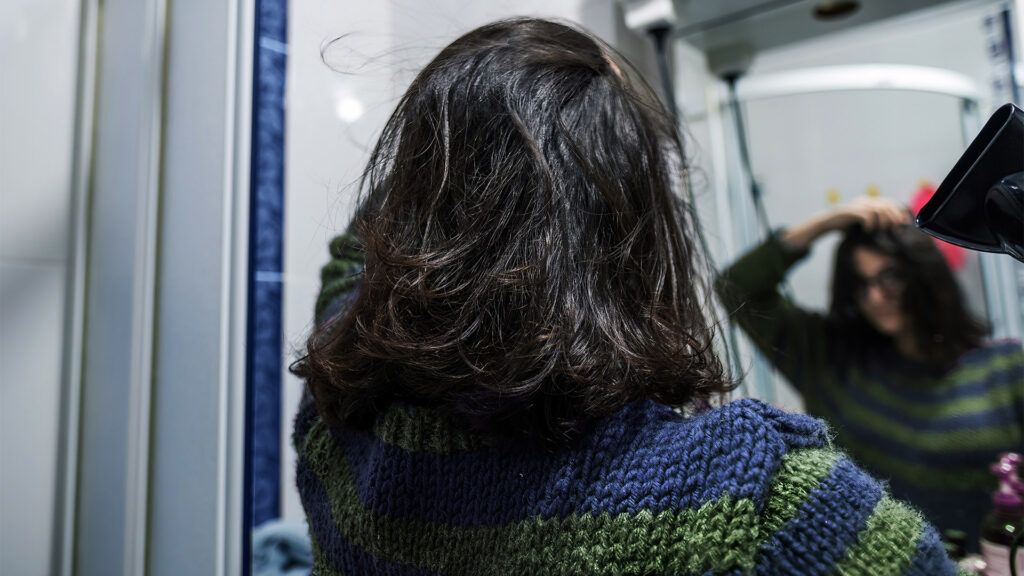Scalp rosacea is an uncommon skin condition causing discoloration or redness and pus-filled bumps on the top of the head. It tends to affect males in an atypical pattern.
Rosacea is a chronic skin condition. It typically affects the face, causing redness or darkening of the skin and visible blood vessels. Sometimes, the
Facial rosacea occurs most commonly in adults between
In contrast, scalp rosacea is more common in older males with hair loss. Scalp rosacea appears as pustules on red or darker brown irritated skin.
This article covers scalp rosacea, its potential complications, and how doctors diagnose it.

Rosacea is a chronic inflammatory skin condition that usually affects the central face. However, people can also develop rosacea on the scalp.
Those with fair sun-sensitive skin have the greatest risk for rosacea. Experts estimate the prevalence of this skin condition in this population as
In contrast, scalp rosacea is an uncommon diagnosis, and
Firm, yellow, brown, or red papules or nodules on the skin characterize granulomatous rosacea. These lesions can be severe and cause scarring.
Scalp rosacea symptoms
Scalp rosacea presents with a distinct set of symptoms that
- Erythema: This refers to redness of the scalp, which can be mild to severe. It may appear purple or brown depending on skin tone.
- Pustules: This involves the development of pus-filled bumps on the scalp.
- Burning and itching: Individuals with scalp rosacea may experience burning sensations and persistent itching in the affected area.
Risk factors
While the exact cause of scalp rosacea remains unclear, several risk factors can contribute to the development of the condition. These
- Genetics: A family history of rosacea can increase a person’s susceptibility to developing scalp rosacea.
- Facial rosacea: Sometimes, a person with scalp rosacea
may present with mild facial lesions. - Environmental triggers: Exposure to sunlight, temperature extremes, and wind can exacerbate scalp rosacea.
Reports of scalp rosacea complications are uncommon. However, without management — or in severe cases — it could potentially lead to hair loss or alopecia.
Prolonged inflammation and irritation of the hair follicles that scalp rosacea causes may damage the follicles over time. Consequently, individuals with scalp rosacea
Scalp rosacea diagnosis involves a thorough examination of the affected skin by a primary care physician or dermatologist. There is
Doctors may check a person’s medical history and ask about potential triggers.
After starting treatment or ruling out certain conditions, follow-up appointments to assess how someone responds to treatment and if symptoms have changed or improved may be necessary.
What other condition could it be?
Several other conditions may appear with symptoms
- acne
- flushing
- seborrheic dermatitis, an inflammatory skin condition
- keratosis pilaris rubra, a subtype of keratosis pilaris
- acute cutaneous lupus erythematosus, an autoimmune condition that causes skin rashes
- drug-induced acneiform eruption, which occurs when medications induce acne-like lesions
Managing scalp rosacea typically involves a
- topical treatments
- oral medications
- lifestyle modifications
Learn more about treating rosacea.
Medications aim to reduce inflammation, although topical steroids may cause rebound flaring of symptoms.
Though research is limited, case reports and some scientific literature note
People should also take note of any triggers, such as UV light or alcohol, and take steps to avoid them. Some skin care tips for rosacea are to use:
- pH-balanced skin cleansers instead of soap
- broad-spectrum sunscreen of SPF 30 or more
- moisturizers
Consultation with a dermatologist is essential to develop an effective management plan specific to an individual’s needs.
Scalp rosacea is less common than facial rosacea. Rather than affecting younger females as rosacea does, it tends to affect older males with hair loss. It may present as pustules on red or darkened and irritated skin.
Symptoms might include red or purple pustules on the scalp, which can be uncomfortable and itchy.
Treatment aims to reduce inflammation, and people can learn to avoid their specific triggers. Effective management can significantly improve symptoms of this relatively uncommon condition.
